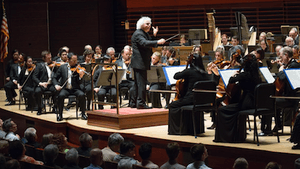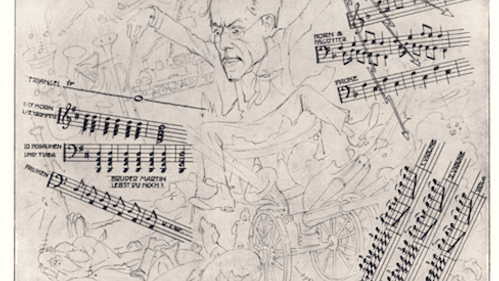Stay in the Loop
BSR publishes on a weekly schedule, with an email newsletter every Wednesday and Thursday morning. There’s no paywall, and subscribing is always free.
How many hammer blows does fate need?
Simon Rattle returns to the Philadelphia Orchestra

It was the concert that almost didn’t happen. Sir Simon Rattle’s eagerly anticipated performance of Mahler’s Sixth Symphony with the Philadelphia Orchestra was a one-off in the Orchestra’s subscription series. The sudden strike that canceled last week’s remaining concerts threatened it as well, and much else.
The orchestra’s last strike, in 1996, lasted 64 days, killing a large part of the season. This one lasted 48 hours, but was swift and bitter enough to leave a gala audience — including major philanthropists and donors — booing the musicians as they exited the Kimmel Center to play for the passing street audience. If that doesn’t send a message to this city about the state of one of its most precious cultural institutions, the next one won’t just be a shot across the bows. It may be one at the heart.
Playing games with Philly's treasures
The Westminster Choir, which sang Mozart’s Mass in C Minor superbly the previous evening and was prepared to perform again, was reportedly caught off guard by the strike. So, presumably, was music director Yannick Nézet-Séguin, who left town without comment. The music director is the leader of the orchestra. He is also an employee with his own separate contract and reporting relationship to the orchestra administration and board. It is a dual role that has undoubtedly caused some strain of late.
If you think this isn’t high-stakes poker, you haven’t been around a card table for a while.
None of this was apparent in the orchestra’s performance of Mahler, yet another tribute to its consummate professionalism and dedication to the music it serves. The only indication of what occurred the previous weekend was the warmth with which the audience greeted concertmaster David Kim. Maestro Rattle, too, entered as if nothing had threatened his Philadelphia appearance, and conducted a robust performance with his customary élan.
The whole world in a symphony
Mahler had five symphonies yet in his quill when he completed the Sixth in the summer of 1904 (depending on whether you count his unfinished 10th Symphony, heard here last May, and Das Lied von der Erde, the song cycle some critics consider a symphony in all but name). The Sixth, though, is in many respects his summa, the utmost stretch of the genre. For this listener, it is the greatest symphony of the 20th century, and perhaps its greatest symphonic work.
Curiously, some critics have described the Sixth as the most “classical” of Mahler’s symphonies, a term that implies austerity and restraint as well as traditional form. Yes, the Sixth is a four-movement work with clearly stated themes, a key signature that remains a constant, a repeat exposition in the first movement, and the more or less normal succession of movements: Allegro, Andante, Scherzo, Allegro (although this order has never been definitively settled). This, however, is mere scaffolding.
From its opening bars, the music plunges one into a tempest of sound that is scarcely relaxed even in the Andante. Its moods are varied, overlapping, and conflicting, frequently at the same time, and its inner textures are rich with the micro-events that began to characterize Mahler’s music from the Fifth Symphony on. Mahler once remarked that one should attempt to get the entire world into a symphony, and certainly his world is present in the Sixth as perhaps the most kaleidoscopic self-portrait of one of the most complex and commanding personalities in musical history. Its content recognizes no constraint, and such is its power that by its epic Finale, the listener must simply surrender.
More than one "tragische"

In the last of the three sets of performances Mahler conducted, The Sixth was dubbed “Tragic.” No one knows who gave it this title; it appeared in none of the score’s published editions. The only concrete suggestion of such a program in the work is, perhaps, in the hammer-blows of a giant mallet that punctuate the Finale. Did Mahler mean to signify the inexorability of fate? In the original version of the symphony, he did specify that the mallet be struck five times, but reduced these to three and finally to two. They needed no extra-musical associations to make their point. The Sixth is a pile-driver of a symphony, and these blows may be read, simply enough, as exclamation points.
The question of the inner movements is trickier. Mahler conducted his own performances with the Andante first, but his widow, Alma, said after his death that he had decided to reverse the order as per the original version of the score. Most conductors now prefer the Scherzo first, as do I, but Rattle made a plausible case for connecting the Scherzo to the colossal torso of the Finale.
Rattle’s was a dynamic reading of the work as a whole, urgent but never forced, and with an eye for detail. The latter is critical, given Verizon Hall’s still-mediocre acoustics. Seated in the orchestra section, I watched but could not hear as the percussionist sounded her triangle, and wondered how the harpist was doing. Even in a bad auditorium you will hear a lot of notes in Mahler, but it would be nice to hear them all without having to travel to New York, Boston, or Cleveland.
Mahler, then, triumphed. But this performance, under these circumstances, sounds another note: alarm, for one of the world’s great cultural institutions, which continues to operate in crisis. So far, the orchestra has maintained its high standard. But Philadelphia should stop riding its luck, before it’s too late.
What, When, Where
Simon Rattle Returns. Gustav Mahler, Symphony No. 6 in A Minor. The Philadelphia Orchestra, Simon Rattle conducted. Oct. 6, 2016 at the Kimmel Center, 300 S. Broad St., Philadelphia. (215) 893-1999 or philorch.org.
Sign up for our newsletter
All of the week's new articles, all in one place. Sign up for the free weekly BSR newsletters, and don't miss a conversation.

 Robert Zaller
Robert Zaller